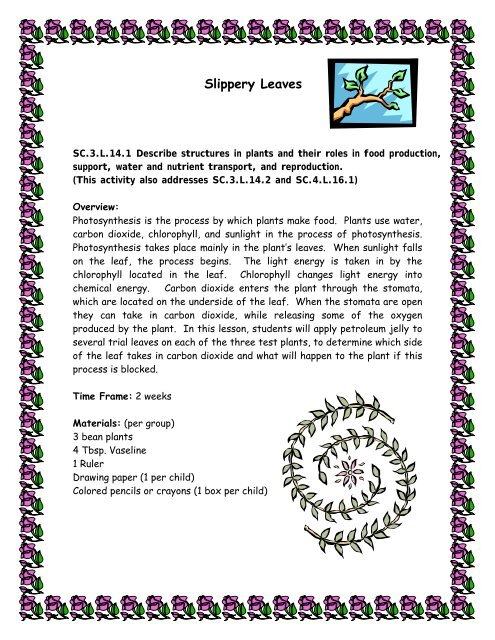SC.3.L.14.1 Slippery Leaves - Science
SC.3.L.14.1 Slippery Leaves - Science
SC.3.L.14.1 Slippery Leaves - Science
Create successful ePaper yourself
Turn your PDF publications into a flip-book with our unique Google optimized e-Paper software.
<strong>Slippery</strong> <strong>Leaves</strong><br />
<strong>SC.3.L.14.1</strong> Describe structures in plants and their roles in food production,<br />
support, water and nutrient transport, and reproduction.<br />
(This activity also addresses SC.3.L.14.2 and SC.4.L.16.1)<br />
Overview:<br />
Photosynthesis is the process by which plants make food. Plants use water,<br />
carbon dioxide, chlorophyll, and sunlight in the process of photosynthesis.<br />
Photosynthesis takes place mainly in the plant’s leaves. When sunlight falls<br />
on the leaf, the process begins. The light energy is taken in by the<br />
chlorophyll located in the leaf. Chlorophyll changes light energy into<br />
chemical energy. Carbon dioxide enters the plant through the stomata,<br />
which are located on the underside of the leaf. When the stomata are open<br />
they can take in carbon dioxide, while releasing some of the oxygen<br />
produced by the plant. In this lesson, students will apply petroleum jelly to<br />
several trial leaves on each of the three test plants, to determine which side<br />
of the leaf takes in carbon dioxide and what will happen to the plant if this<br />
process is blocked.<br />
Time Frame: 2 weeks<br />
Materials: (per group)<br />
3 bean plants<br />
4 Tbsp. Vaseline<br />
1 Ruler<br />
Drawing paper (1 per child)<br />
Colored pencils or crayons (1 box per child)
Procedure:<br />
1. Label the first plant “A.”<br />
2. Label the second plant “B.”<br />
3. Label the third plant “C.”<br />
4. Put the 3 plants on a sunny windowsill.<br />
5. Draw a picture of each plant.<br />
6. Measure and record the height of all three plants.<br />
7. Rub Vaseline on the top of several of the leaves on plant “A.”<br />
8. Rub Vaseline on the underside of several of the leaves on plant “B.”<br />
9. Plant “C” remains as is.<br />
10. Water all three plants the same.<br />
11. Measure and record the growth of each plant every other day.<br />
12. Draw pictures of any changes taking place.<br />
Assessment:<br />
• Explain what happened to the three plants and why air is necessary<br />
for photosynthesis.<br />
Home Learning:<br />
Write up the experiment. Be sure to include your problem statement and<br />
hypothesis.
















